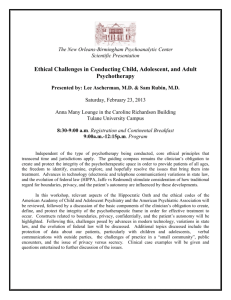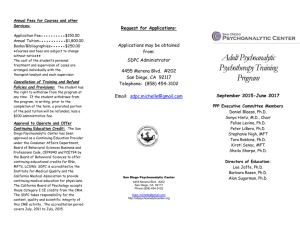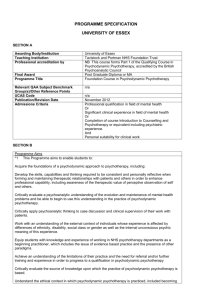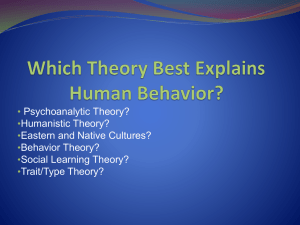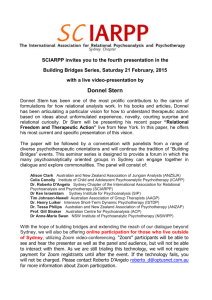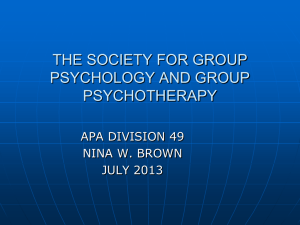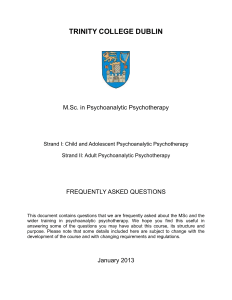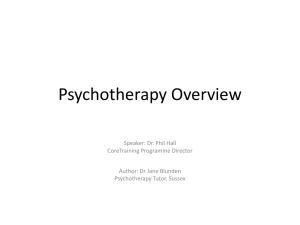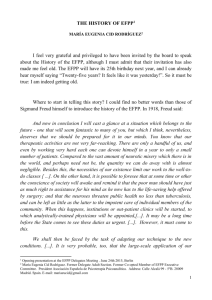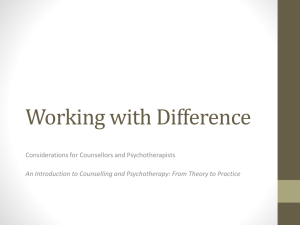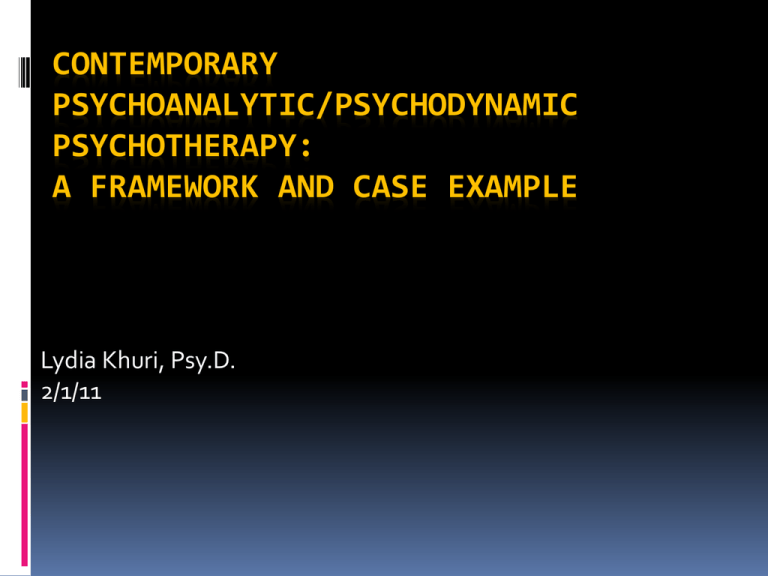
CONTEMPORARY
PSYCHOANALYTIC/PSYCHODYNAMIC
PSYCHOTHERAPY:
A FRAMEWORK AND CASE EXAMPLE
Lydia Khuri, Psy.D.
2/1/11
Outline
Framework*
Theoretical assumptions
Psychoanalytic sensibility
Multicultural/feminist critiques
Empirical research
Preparing the therapist
Preparing the client
Therapy process
Boundaries
Case Material
*based on Nancy McWilliams (2004) and Jonathon Shedler (2010)
Learning Objectives
You will be able to identify components of the
psychoanalytic psychotherapy framework
You will be able to identify components of the
framework as applied to a case study
Contemporary Psychoanalytic
What comprises psychodynamic psychotherapy?
(Shedler, 2010)
1.
2.
3.
4.
5.
6.
7.
Focus on affect and expression of emotion
Exploration of attempts to avoid distressing thoughts and feelings
Identification of recurring themes and patterns
Discussion of past experiences (developmental focus)
Focus on interpersonal relations
Focus on therapy relationship
Exploration of fantasy life
Basic Motivational Systems
Contemporary (Lichtenberg, 1989)
1.
2.
3.
4.
5.
Psychic regulation of physiological requirements
Attachment and affiliation
Exploration and assertion
Aversive reaction through antagonism or withdrawal
Sensual enjoyment and sexual excitement
Psychoanalytic Sensibility
Curiosity and awe
Identification and empathy
Subjectivity and attunement to affect
Attachment
Faith
Multicultural/feminist Critiques
Feminist critique of inherent androcentrism
Biologically-based gender differences
Reification of power relations between men & women
Normative gender and sexual development
Deterministic (personality patterns established in
early development)
Feminist principles
Personal is political
Commitment to change on social level
Female subjectivity
Egalitarian therapeutic relationship
Focus on strengths
Recognition of interlinking of oppression
Multicultural/feminist Critiques
Multicultural critique of Western worldview
Role of the past
Blaming parents
Concept of trauma
Family structures
Autonomous self
Multicultural principles
Focus on cultural identity in relation to psychological well-
being
Understand power in therapy and larger social contexts
Understand worldviews
View of human nature
Orientation toward time
Definition of proper human activity
Definition of social relations
Understanding of relationship of people and nature
Empirical Research*
Psychoanalytic psychotherapy as effective as other
empirically-supported treatments (effect sizes similar)
2. Core processes and techniques as defined by
psychoanalytic theory are facilitative of change,
regardless of theoretical orientation
3. Effects extend beyond symptom reduction and after
therapy has ended
4. Factors of culturally sensitive therapies have not been
teased apart from “traditional” variables (Sue et al., 2008)
1.
Shedler (2010)
Preparing the Therapist
New therapists make lots of mistakes
Being yourself in role of therapist
Supervision
Own therapy
Broad education
Preparing the Client/patient
Psychotherapy as peculiar relationship
Physical safety
Emotional safety
Informed consent
Encourage spontaneous, candid, emotionally
expressive speech
Introduce work of transference
Boundaries
Therapy Process
Listening
Talking
Facilitation
Power
Therapeutic power
Empowering the client
Love
Major Concepts
Unconscious
As adjective: mental contents not available to conscious awareness
As noun: component of mental system known as id, yet some aspects of ego
(defenses) and superego (moral standards) part of Ucs.
The adjective form is generally accepted in contemporary psychoanalysis
whereas there are several models of the mental system besides Freud’s model
known as structural.
Defense
The ego’s attempt to protect self against danger, overwhelming, or
unacceptable affect and ideas
Repression: exclusion from awareness thoughts and feelings once felt
consciously or never felt consciously; ex., hatred directed at a sibling.
Reaction formation: changing unacceptable thoughts and feelings to
acceptable; ex., longing for loving experience changed into hatefulness
(Moore, B E. & Fine, B. D. (1990). Psychoanalytic terms and concepts. New Haven, CT: Yale University Press.)
Major Concepts
Transference
Displacement of feelings, thoughts, patterns of behavior, originally experienced in
relation to significant figures during childhood, onto a current relationship.
More intensified in psychoanalysis; reveals early patterns
(Moore, B E. & Fine, B. D. (1990). Psychoanalytic terms and concepts. New Haven, CT: Yale University Press.)
Boundaries
Chance encounters
Social invitations
Gifts
Request for other therapy
Disclosure
Touch
Sex
Case Material: “James”
James’s reasons for seeking therapy
My early clinical impressions
James’s personal history
Phases of therapy
Beginning
Middle
End (“Termination”)
Post termination
Reasons for Seeking Therapy
Referred by a university mental health center
for longer term psychotherapy
Crisis about major
Symptoms of depression
Sense of feeling lost
Feeling effects of parents’ divorce two years
ago
James’s Initial Presentation
Monotone & restricted expression of affect
Image of wave (overwhelming feelings)
Anxiety
“Waiting” expression
Subtly vigilant
Pleased others & took on feelings of others
Didn’t want to make waves
My Early Impressions
Earnest
General vagueness in contrast to moments of precise insight
Strengths
Attentive
Thoughtful, intelligent
Sense of humor
Willing to try
Types of defenses
Reversal
Exhaustion/keeping extremely busy
“Fogginess”/not noticing things
Lack of “dialogue”
How would I need to be with him?
James’s Personal History
19 y/o, single heterosexual, college student
Father 1st generation Chinese American, not religious, converted to
Catholicism
Sacrificing, wants things to be “normal,” i.e., no conflict
Mother European American, raised Catholic
Alcoholic; affectionate when inebriated but otherwise enraged and
explosive
Parents divorced when James 17 y/o
Younger brother by 4 years
Explosive like mother
Top student in high school
Premed but struggled
Switched to another major with some success
Paying for college himself
Treatment Goals
Not in crisis when he came to me
Exploratory psychodynamic psychotherapy
Feel better
Find his niche, who he was
Therapy lasted 3 yrs, 8 mo’s
How I worked with James
What I did
Listened
Communicated interest and warmth
Explained how therapy works
Provided structure by asking open-ended questions
while remaining attentive to his cues
“What’s your inside life like?”
Reflected back
Did not let silence lapse too long
What I did not do
Interpret too much
Give advise
Initial Phase: Themes
Sadness persisting beyond subsiding of depression
symptoms
Sensitivity to emotional intrusion
Distancing from affect (speaking in second person, e.g.,
“Being alone let’s you think too much.”)
“Squashing” affect (“I don’t like to get too excited about
things.’)
Trouble with initiating conversation
Ambivalence about attachment
Foreshadow process: “I’m afraid to attach b/c it will go away.”
Foreshadow ending: “I don’t know how to do endings.”)
Initial Phase: Progress
Within 4 mo’s
Symptoms of major depression remitted but
paradoxically began to experience persistent, puzzling
melancholy
Met a girl he really liked
Doing better in school but questioning purpose
Insight into emotional pattern: turn anger into sadness
Insight into family dynamics: mother doesn’t “see”
him; father didn’t intervene
By 6th Month
Could tolerate my having separate mind to mirror him
Second Phase
Long phase of exploration
Talked more openly but still trouble initiating
conversation
Sadness more accessible if not sources
Focus on current life
Weathered ups and downs with girlfriend
Left school to work full time
Attempted to integrate painful truths about his
family he learned while in therapy
Parents marrying b/c mother was pregnant
Second Phase: Themes
Anger
Self-assertion
Ambivalence about cultural identity
Loss of closeness to father
Ambivalence about growing up
Fear of dependency and separation (felt less
of it in relation to me)
Second Phase: Progress
Seeking others to express dependency needs and
allowing attachments (girlfriend; friends)
Explore own power and authority (trusting own
feelings; role as manager)
Able to talk about therapy itself; what needed from
me
Able to take in my mirroring about positive aspects of
self
“You’re sadness isn’t just buried. There’s also aliveness and
spontaneity.”
Termination
Initiated by James
We agreed on a date (three months hence)
Tolerated some exploration of meaning &
feelings
Consolidation and On-going issues
Consolidated Changes
Behavior
Initiated separation from me
Tolerated exploration of motivation
Better social network of friends
Long lasting romantic relationship & commitment to future
Stand up to girl friend
Promotion at work
Able to set some limits/say “no” at work
Initiated separation from family w/out “cutting them off”
Intrapsychic
Greater range of expressed affect
Moments of experiencing grief for past
Tolerate ambivalence better
Consider own needs and feelings
Saw parents in more realistic light
Acknowledge ambition
Remaining Issues
Effects of mother’s issues & alcoholism
Caretaker
Substitute husband
Persistent hope for more closeness with both
parents based on infant/childhood needs
Unresolved issues about surpassing parents’
academically, especially father
Fear of dependency and rage
Transference
In behavioral terms “stimulus generalization”
Old relational paradigm
Took care of me by not burdening me with his needs, feelings, or
hopes
I would be indifferent or hostile if he expressed needs
He waited for me to take lead
New relational paradigm
I was a calming, understanding presence (but kept at a distance)
My subjectivity did not overwhelm his
I gave him time to think (literally)
He could explore his need for me to take lead
He could initiate separation from me and not be undermined by
guilt
Countertransference
Strong personality
Fleeting moments of boredom and rage
Different defenses to deal with dependency
issues
Me: action/ambition/grandiosity
James: passivity/floating/shrinking
Distanced from his helplessness and “inner
deadness” to avoid confronting my own
Own on-going therapy and paid consultation
Post-therapy Contact
Able to explore with my support
Able to acknowledge limitations of therapy
relationship
Relieved that he could come back (“safety
net”)
Called several months later
Engaged
Doing well
Therapist recommendation for fiancée
End
“If change were easy, psychotherapists would be out of a job.”
Nancy McWilliams, Psychoanalytic Psychotherapy: A Practitioner's Guide
Suggested Reading
Lowder, G., Hansell, J., McWilliams, N. (n.d.) The enduring significance of
psychoanalytic theory and practice. Retrieved February 9, 2008 from
http://www.division39.org/sec_com_pdfs/PsychoaResearchPP.pdf
McWilliams, N. (2003). Psychoanalytic psychotherapy: A practitioner’s guide.
New York: Guildford press.
Milrod, et al (2007). A randomized controlled clinical trial of psychoanalytic
psychotherapy for panic disorder. American Journal of Psychiatry, 164(2): 265272.
Shedler, J. (2010). The efficacy of psychodynamic psychotherapy. American
Psychologist, 65(2), 98-109.

